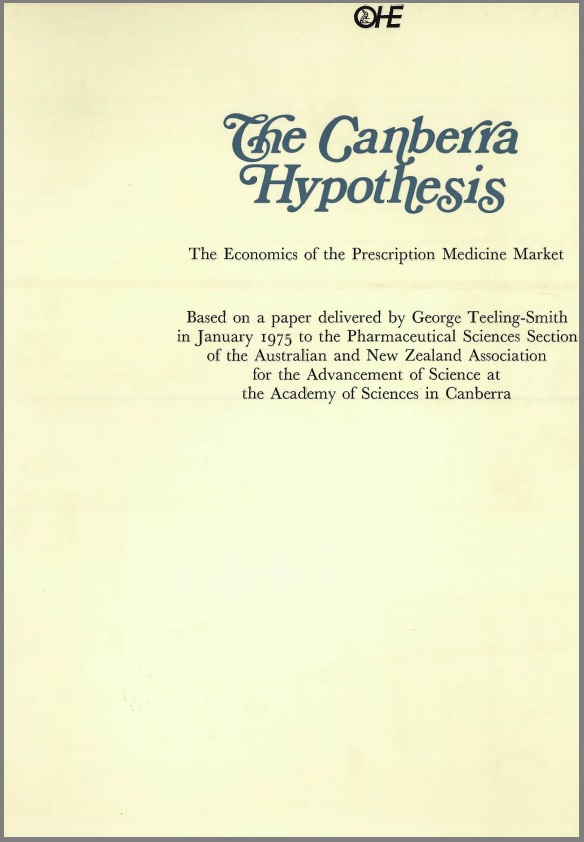The Office of Health Economics delivered a paper to the Pharmaceutical Sciences Section of the Australian and New Zealand Association for the Advancement of Science at the Academy of Sciences in Canberra.
The burden of this paper was that it was a fundamental misconception to believe that price competition was lacking in the prescription medicine market, at least in the context of the British National Health Service. The ‘Canberra Hypothesis’, as it could be called, stated that the market success of a prescription medicine would, other things being equal, be affected by its price relative to alternative products on the market. This strongly challenged the earlier conclusions, which had prevailed over the previous 15 years, that the price of a medicine was a matter of indifference to the prescriber. It supported the assertion of those working in the pharmaceutical industry that in pricing a product one had, to be successful, to consider carefully the relative merits and the relative price of the alternatives in the market.
The paper argued that price competition operated in the prescription medicine market just as it does in the markets, for example, for cars, clothes, comestibles, consumer durables and cosmetics. This present paper is a development of the Canberra Hypothesis, which has had the benefit of advice and guidance from members of the OHE Editorial Board and in particular from two distinguished economists from the OHE Panel of Advisors, Duncan Burn and Tom Wilson. This paper remains, however, a hypothesis. The evidence on which it is based, although apparently convincing, is still fragmentary and falls short of being a strict theoretical proof that price competition exists for prescription medicines.
Nevertheless it calls into question the underlying factor – namely the absence or weakness of price competition for pharmaceuticals – on which price controls, such as Britain’s ‘Voluntary Price Regulation Scheme’, are predicated. The hypothesis also has another topical relevance for Britain in 1975. This is because the government’s controversial proposal to reject the Banks Committee’s recommendation to repeal Section 41 of the 1949 Patents Act was specifically justified on the grounds that ‘competition in the industry is largely based on products and not prices’. If the
Canberra Hypothesis can be proved this statement is incorrect. Thus the government’s decision to continue discrimination against pharmaceuticals in British Patent Law, like the ‘Voluntary Price Regulation Scheme’, would be seen to be based on a false premise.
In fact, at the same time as publishing this paper, OHE has taken steps to see whether the hypothesis can indeed be tested and proved. Duncan Reekie of the Department of Business Studies at the University of Edinburgh, with the approval of his head of department, Norman Hunt, has undertaken to conduct this exercise on behalf of OHE.
His starting point will be the working papers for the study of Innovative Activity in the Pharmaceutical Industry which was completed in 1973 by the Centre for the Study of Industrial Innovation on behalf of the Pharmaceutical Working Party of the Chemicals Economic Development Committee. This study identified all the new single pharmaceutical chemical entities introduced onto the British market between 1957 and 1970. It evaluated them in terms of their therapeutic significance at the time of introduction and in terms of their subsequent market success.
There was, as one would have anticipated, a significant statistical correlation between therapeutic merit and sales value; that is, other things being equal, the most important products in therapeutic terms were also those which sold most successfully. Now Reekie will try to add into the equation, as it were, the cost of the median daily dose for each of these innovations, as compared with those of alternative existing therapies at the time of their introduction. If the hypothesis is correct, there should be once again a significant positive correlation, this time between inexpensiveness and market success. It may be that the sample will be too small or too diffuse to provide this formal statistical proof. The evidence and discussions in this present paper, however, makes it almost inconceivable that Reekie’s results would support the reverse proposition – namely that more expensive prescription medicines will, other things being equal, achieve greater market success than their more modestly priced competitors. Yet, as this paper describes, that alternative ill-conceived hypothesis is the one which has reigned supreme in many academic and government circles since the early 1960s.
